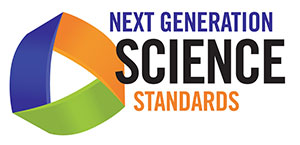 In recent developments, NYS has decided for the 2013-2014 school year, to not make a decision regarding adoption of the Next Generation Science Standards.
In recent developments, NYS has decided for the 2013-2014 school year, to not make a decision regarding adoption of the Next Generation Science Standards.
A major goal of the NGSS and an expectation for its successful implementation is for students to build and apply ideas in a coherent manner or progression within each year or course, and over the 13 years of their K–12 educational experience. It is important for all stakeholders to understand that the NGSS is a set of standards and do not dictate a particular curriculum nor advocate for the use of specific instructional materials. It is the task of states and/or districts to establish a curriculum and to develop and/or select instructional materials aligned with the NGSS. Aligned materials integrate the three dimensions of scientific and engineering practices, disciplinary core ideas, and crosscutting concepts. A curriculum that is aligned provides a sequence of topics within each grade and grade band from kindergarten to grade 12 that is consistent with the progression of core ideas from the NGSS. This, most likely, will require a significant change in the structure of courses and the total K–12 curriculum sequence that currently exists. Appendix K of the NGSS provides extensive guidance in this process.
With this being said, even if NYS eventually decides not to adopt these standards, there are some valuable concepts found in these standards that can be implemented in classrooms. The NGSS do not just lay out the facts of science; they demonstrate the learning practices of science — such as controlling variables consistently over multiple trials. These will fit well in any classroom!
The eight practices of science and engineering that the NGSS identifies as essential for all students to learn and describes in detail are listed below. These engineering practices should also not be ignored, even if NYS decides not to take these standards on.
1. Asking questions (for science) and defining problems (for engineering)
2. Developing and using models
3. Planning and carrying out investigations
4. Analyzing and interpreting data
5. Using mathematics and computational thinking
6. Constructing explanations (for science) and designing solutions (for engineering)
7. Engaging in argument from evidence
8. Obtaining, evaluating, and communicating information
While most teachers of science truly believe they are already utilizing these practices in their classroom, I encourage you all too really take a deep look at your teaching and explore these practices. You might surprise yourself!
I feel that the NGSS have a chance to be a real game changer for our students, but not without its challenges. We must continue to identify the challenges and create supports for all those that will be affected by the change. If NYS does decide to adopt these standards, I hope the implementation process is done in a very deliberate manner, and with integrity. We owe it to our teachers and students to not have a repeat of what we have seen with the common core adoption!

